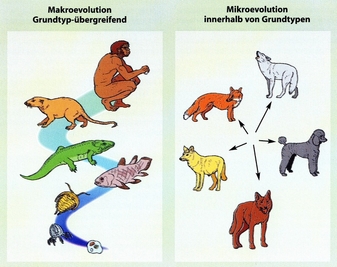 |
 |
 |
 |
 |
 |
 |
 |
|
 |
 |
 |
01 Micro and macro evolution
|
| Menu | back |
There is not a single verifiable example of macro evolution. A succession of micro evolutionary events does not result in macro evolution because no new organs, structures or functions are created and no increase of information in the respective creatures genetic material takes place. Added to that is the fact that some micro evolution observed today proceeds 10,000 to ten million times faster than that generally derived from fossils.
Developments, genetic alterations in individuals and in the succession of generations really do occur. A good example of this is the development of breeds within a biological species. In this way, from the grey wolf species (Canis lupus) hundreds of breeds of dog originated, from Pekingese to St Bernard. Dog, however, remains dog. That is micro evolution.
Great variability is observed within a non-exceeded bandwidth. A broad development of breeds has taken place, especially with regard to domestic animals. With these, man has garnered mutations, crossed them with each other and selected according to his preference. In this way, for instance, the rock dove breed (Columba livia), in which Darwin took a lot of interest, has been subdivided into over a thousand breeds by breeders.
|
 |
|
During his research expedition to the Galapagos Islands, Darwin collected different finch specimens. A remarkably large number of species of finch can be found on these Pacific islands. In total, thirteen species, which differ significantly in body size, and beak size and shape, can be identified.. These Darwin finches are often invoked as proof of evolution in general, although it is indisputable that the changes in these birds lie within the domain of micro evolution. These different variations are still finches and will continue to remain finches (1).
Mikro- & Makroevolution | |
Macro evolutionary developments:
According to Darwins teaching on the origin of species, living organisms should, in their biological history, be able to create completely new, not previously present, complex blueprints, organs and functions by spontaneous events in their genetic machinery, mutation, selection, gene transfer, combination of gene segments, gene duplication and other factors. In this sense, the term higher development is generally used.
In an assumed case of higher development for instance; mammals from reptiles, structures such as hairs, milk glands, mechanisms for controlling temperature and everything else that differentiates mammals from reptiles would have to emerge.
These supposedly newly-created structures do not differ from the old structures by only one gene but usually by many genes, whose spatial and chronological activity patterns must be compatible with one another. With macro evolutionary processes, this would have to be the case with each individual intermediate form. The orchestra of genes must always be in tune.
What is evolution?
The Dutch Standaard Encyclopedie under the heading "Evolution" reads as follows: Macro evolution, which embraces the periodic appearance and dispersal of new groups as happens in the course of the geological periods, and which affects the higher orders of classification such as genera, families and orders or classes, cannot be accounted for directly by experimental genetics. The assumptive hypotheses based on the drastic alteration of genetic traits, cannot, in fact, be proved.
The causes, which are supposed over the course of millions of years to have led to the increased complexity of living creatures, are unknown. The biologist Willem J. Ouweneel concludes that genetics does not provide a basis for belief in macro evolution. In his opinion it emphasises quite the opposite: that the original forms of life, mostly the species but sometimes the genera and even perhaps the families, as variable as they may be, are as a whole constant and mutually discontinuous (2).
Rapid speciation and/or micro evolution:
That micro evolution takes place is not disputed. Indeed, it is also documented that it can proceed 10,000 to ten million times faster than that claimed for many fossil sequences (3) (4).
Contrary to previous assumptions, animals can adapt to changing environmental conditions within a few generations (5). Thus, it is clear that for palaeontologically proven micro evolutionary processes, from a biological point of view, no greater timescales were required (6).
These 02 | Menu |
| back |
(1) Helmut Schneider, Natura, Biologie für Gymnasien, Band 2, Lehrerband, Part B, 7. to 10. Schuljahr, Ernst Klett Verlag, 2006, page 274.
(2) Willem J. Ouweneel, Evolution in der Zeitenwende, Christliche Schriftenverbreitung Hückeswagen.
(3) Virginia Morell, Predator-free guppies take an evolutionary leap forward, Science 275, 28. March 1997, page 1880.
(4) Stephen Jay Gould, The paradox of the visibly irrelevant, in: The Lying Stones of Marrakech, Frankfurt/M., 2003, pages 411429.
(5) Klaus Neuhaus, Schnelle Anpassung von Leguanen (Anolis) an neue Lebensräume (The rapid adaptation of iguanas to new habitats), Studium Integrale 1997/4, pages 8183.
(6) Uwe Brüggemann, Studium Integrale 1998/1, pages 3839.
|
(Image "Mikro- & Makroevolution") Reinhard Junker und Siegfried Scherer, Evolution ein kritisches Lehrbuch, 2006, page 52.
|
| |
Comment this Site!
Stefan SEVCIK wrote:
I agree with above proposition, even further evidence in support of this position can be found in scientific literature: "The central question of the Chicago conference was whether the mechanisms underlying microevolution can be extrapolated to explain t
|
 |
 |
 |
 |
|


